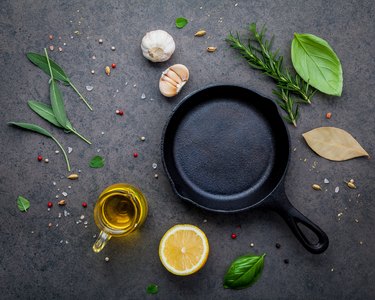
Almost every "healthy" recipe calls for a cooking spray to coat the pan. But the aerosol method of application may make you suspicious of its additives, such as dimethyl silicone, an anti-foaming agent.
If you aren't convinced that cooking sprays are the best choice, making a homemade, healthy cooking spray alternative using olive oil and a pump bottle guarantees a safe spritz.
Video of the Day
Video of the Day
Can't Beat the Convenience
Cooking sprays create a thin layer of oil and lecithin so food doesn't stick to the pan or pot when you're sauteing it. They also make for quick greasing of a baking pan so muffins, cupcakes or cookies slide right out.
While a pat of butter or tablespoon of oil does the same job, these add more fat and calories than you might want in your dish. In addition, butter is high in saturated fat — the kind that can increase your risk of heart disease, according to the American Heart Association.
These sprays contain a form of vegetable oil, such as corn, soy, canola or olive oil, along with soy lecithin, which emulsifies the product. To enable the spray to work and to prevent foaming or clogging, manufacturers usually include a propellant agent, silicone and a bit of alcohol.
Know the Safety Concerns
The hydrocarbons in cooking sprays could pose a danger if you use the spray near open flames — such as on a lit grill or on a pan heating over a gas burner, as advised by Washington State Department of Labor & Industries.
To be safe, spray the cooking surface while it's cool and no flames are in sight. Any sprays that do contain this flammable hydrocarbon should specify so on the label. For the healthiest and safest choices, look for ones that do not.
Pump It Yourself
A reusable pump eliminates waste from used aerosol cans, keeping the environment healthier, and ensures you control the ingredients. Purchase these pumps at cooking supply stores and fill with an oil of your choosing.
Instead of artificial chemicals creating the pressure to release the oil — you press a button that pumps the oil into a cylinder. Increased internal pressure in the cylinder releases the oil in small spritzes onto your pan or baking dish.
You minimize the amount of oil used and still have all the convenience of a spray without any additives.
Choose Healthy Oils
Whether you fill a reusable pump or opt for commercial sprays, choose olive oil. Olive oil is high in monounsaturated fats, which are linked to healthier cholesterol ratios, according to an April 2018 article published by Nutrition, Metabolism & Cardiovascular Diseases.
If you fill your own pump, go one step further and choose virgin or extra-virgin oil, which contain antioxidants called polyphenols, which may fight inflammation in the body.
If you plan to do high-heat cooking, such as a stir-fry, grapeseed oil is another heart-healthy option with a high smoke point.
A Few Other Considerations
Canola oil is another heart-healthy option, but it is not without controversy. Some health experts point to it as a highly processed option, with much of the crop genetically modified. To avoid genetically engineered canola oil, opt for organic versions.
Other healthy oils, such as avocado and walnut oil, are not suitable for high-heat cooking because they burn easily. Avoid cottonseed oil-based sprays as these are highest in pesticides and contain a lot of saturated fats.